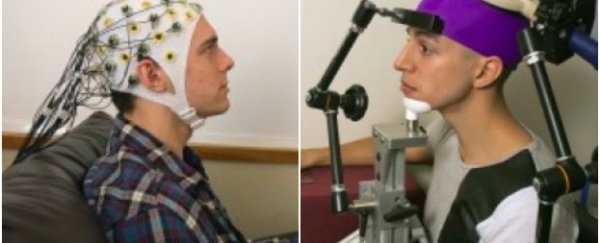Researchers from the University of Washington in the US have managed to non-invasively link-up two people's brains and allowed them to communicate without speaking.
This is the second time they've succeeded in creating this brain-to-brain communication, one year after they first showed it was possible, and it brings the ability closer to real-world applications.
The new study involved six people put into pairs. In the experiment, the researchers successfully transmitted the signals from one person's brain over the internet and used them to control the hand movements of their partner, who was 800 metres away, within a split second. Their results are published in PLOS ONE.
"The new study brings our brain-to-brain interfacing paradigm from an initial demonstration to something that is closer to a deliverable technology," said co-author Andrea Stocco, professor of psychology from the University of Washington, in a press release. "Now we have replicated our methods and know that they can work reliably with walk-in participants."
In order to set up the real-time mind link, the researchers hooked up one person in each pair (the sender) to an electroencephalography (EEG) machine and read their brain activity. Their brain waves were then converted into electrical pulses and sent via the web to the person on the other end of the link (the receiver), who wore a swim cap with a transcranial magnetic stimulation coil placed near the part of the brain that controls hand movements.
This meant that the thoughts of the first person could be translated into hand movements in the second.
The pairs in each experiment were placed into separate buildings around 800 metres apart, and they were unable to interact with each other in any way other than via their thoughts.
In the study, the three senders were playing a computer game where they had to fire a cannon in order to intercept rockets and defend a city. But they couldn't actually perform the task themselves, they just had to think about it and then the signal would hopefully cause the receiver in the other room to hit the fire button at the right time.
The receivers couldn't see the game and simply had their hands hovering over a random touch pad until they were triggered to move by the senders thoughts - something that took less than a second.
The accuracy of the canon firing varied among the pairs, ranging from 25 to 83 percent, but most misses were due to a sender failing to accurately execute the "fire" command. The researchers were able to quantify the exact amount of information that was being transferred between the two brains.
Using the setup, the messages of the receiver were transferred into hand movements in less than a second.
Research by french and spanish scientists earlier this year also showed a direct link between participants in India and France, but this is the first time brain-to-brain connection has been replicated in more than one pair of participants.
The group have now received a $1 million grant in order to develop their connection further so that they can convey images and even information from brain to brain.
They're hoping in the future they'll be able to monitor whether airplane pilots are getting sleepy, and then use this brain-to-brain link to stimulate the copilot's brain.
They're also hoping it could help people teach others via their thoughts.
"Imagine someone who's a brilliant scientist but not a brilliant teacher. Complex knowledge is hard to explain - we're limited by language," said Chantel Prat, a psychologist and co-author of the paper, in the release.
Source: ScienceDaily
